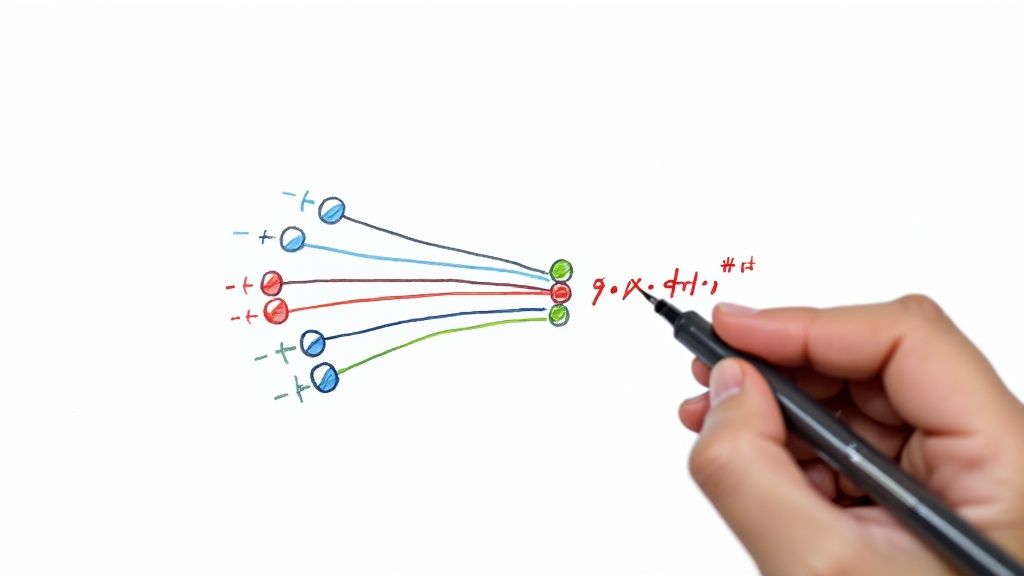Top CI/CD Security Best Practices to Secure Your Pipeline
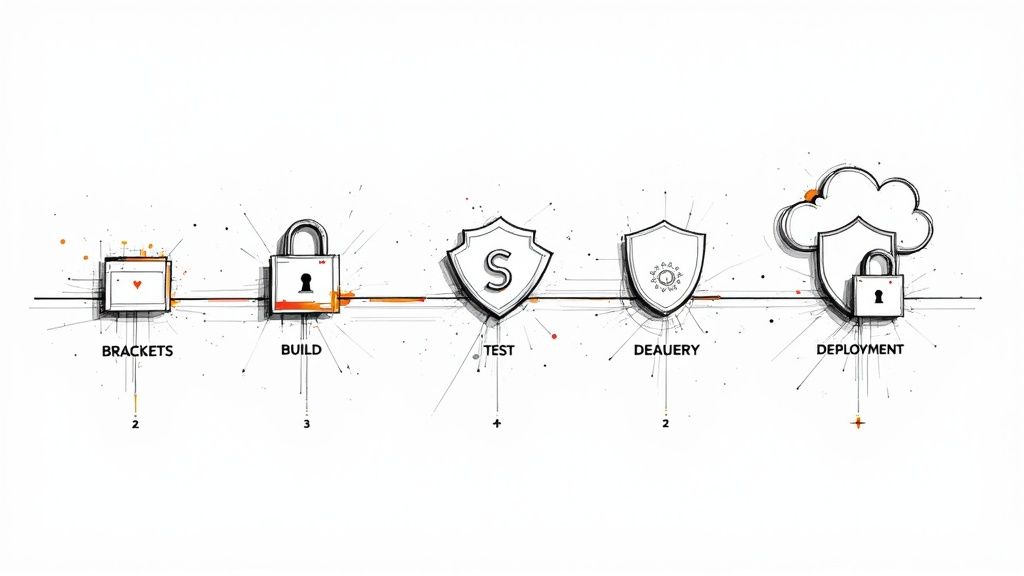
Building a Secure CI/CD Pipeline: A Comprehensive Guide
This listicle provides eight essential CI/CD security best practices for building a robust and secure software delivery process. Learn how to integrate security throughout your application lifecycle, covering crucial areas like code scanning, secret management, supply chain security, IaC security, container security, access control, artifact management, and security testing automation. Implementing these CI/CD security best practices protects your applications and data from emerging threats.
1. Secure Code Scanning and SAST Integration
One of the most crucial CI/CD security best practices is integrating Secure Code Scanning and Static Application Security Testing (SAST). This practice involves embedding automated security code analysis tools directly into your CI/CD pipeline. SAST tools analyze source code without actually executing it, examining the code structure, data flow, and syntax to identify potential security weaknesses, vulnerabilities, and coding errors early in the development lifecycle – ideally, before they even reach a testing environment. By catching these issues early, you significantly reduce the cost and effort required to fix them, and prevent them from becoming exploitable vulnerabilities in production. This proactive approach strengthens your overall application security posture and contributes to building more robust and reliable software.

SAST tools offer several key features that make them invaluable in a CI/CD environment. These features include automated vulnerability detection in source code, seamless integration with popular CI/CD platforms like Jenkins, GitLab CI/CD, and Azure DevOps, and support for a wide range of programming languages. Furthermore, they allow custom rule configuration and compliance checking, ensuring adherence to specific security standards and best practices. The ability to provide real-time feedback to developers within their IDEs facilitates immediate remediation of identified issues. Modern SAST tools also incorporate false positive reduction capabilities using machine learning and other advanced techniques, minimizing the time spent on reviewing non-issues.
The benefits of SAST integration are numerous. Early detection of security issues dramatically reduces the cost of fixing them, as vulnerabilities become exponentially more expensive to address the later they are found in the software development lifecycle. Automated scanning significantly reduces the overhead associated with manual security reviews, freeing up security teams to focus on more complex tasks. SAST tools typically provide detailed remediation guidance, assisting developers in understanding the nature of vulnerabilities and how to fix them effectively. As your development team grows and the codebase expands, SAST solutions seamlessly scale to accommodate the increased workload, ensuring consistent security analysis across all projects. Finally, and perhaps most importantly, SAST integration aligns perfectly with existing development workflows, minimizing disruption and maximizing efficiency.
However, it's essential to be aware of the potential drawbacks. SAST tools can sometimes generate false positives, requiring manual review to confirm their validity. If not optimized correctly, SAST analysis can potentially slow down build times. Also, SAST is primarily focused on static code analysis and is therefore less effective at detecting runtime vulnerabilities. Finally, initial configuration and tuning effort are required to optimize the tool's performance and accuracy for your specific environment.
Many leading organizations have successfully implemented SAST as part of their CI/CD pipelines. Netflix, for example, utilizes multiple SAST tools to scan their microservices codebase, ensuring the security of their vast streaming platform. Microsoft integrates security scanning across Azure DevOps pipelines for all its software projects. Shopify also implements automated security checks in its deployment pipeline to maintain the security of its e-commerce platform.
For development teams seeking to integrate SAST into their CI/CD pipelines, several practical tips can ensure a successful implementation. Configure incremental scanning to minimize the impact on build times. Set up security gates that block deployments if critical vulnerabilities are detected. Integrate SAST tools with developer IDEs for immediate feedback during the coding process. Establish clear workflows for vulnerability remediation, including assigning responsibilities and tracking progress. Regularly update scanning rules and security policies to stay ahead of emerging threats. Learn more about Secure Code Scanning and SAST Integration. Organizations like OWASP, Veracode, Checkmarx, SonarQube, and GitHub Advanced Security have played significant roles in popularizing and advancing SAST methodologies and tools.
By implementing SAST effectively, organizations can proactively address security concerns early in the development process, minimizing risks and building more secure and reliable applications. This approach not only improves the overall security posture but also contributes to faster development cycles and reduced costs associated with fixing vulnerabilities later in the software development lifecycle. Therefore, Secure Code Scanning and SAST integration rightfully earns its place as a critical component of any robust CI/CD security strategy.
2. Secret Management and Credential Security
One of the most critical CI/CD security best practices is robust secret management and credential security. This practice involves securely storing, accessing, and rotating sensitive information like API keys, passwords, database credentials, certificates, and tokens throughout the CI/CD pipeline. Why is this so crucial? Because hardcoding credentials directly into source code or configuration files presents a massive security vulnerability. Effective secret management ensures that these secrets are never exposed, instead utilizing dedicated systems with strict access controls and comprehensive audit trails. This approach drastically reduces the risk of unauthorized access and potential breaches. Implementing proper secret management is fundamental for organizations looking to build secure and compliant CI/CD pipelines.
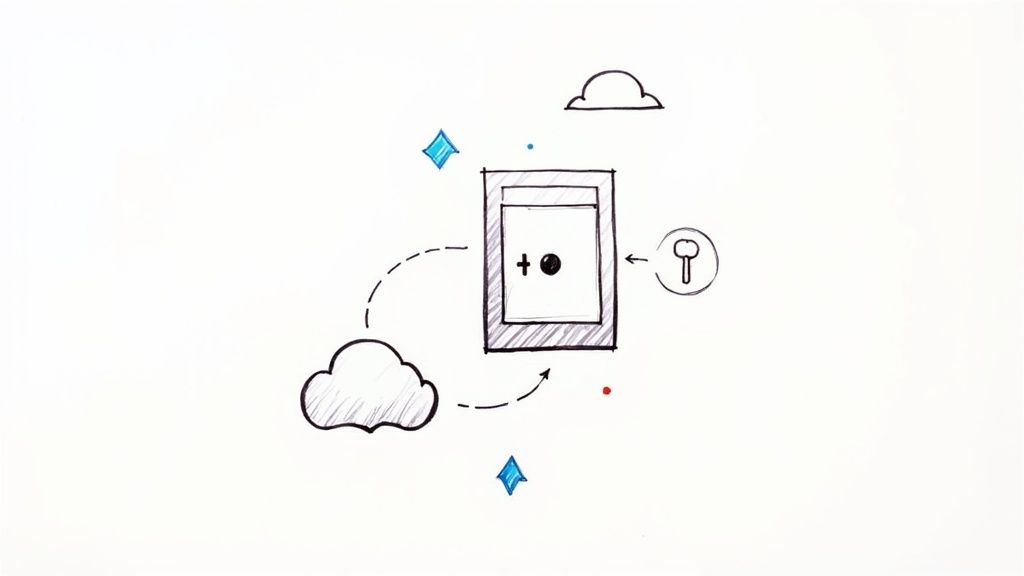
A well-implemented secret management system operates on the principle of centralized, encrypted storage. It acts as a secure vault, protecting sensitive credentials from unauthorized access. Instead of embedding secrets directly into code, applications retrieve them from the secret management system during runtime. This system utilizes fine-grained access controls and permissions, allowing only authorized users and services to access specific secrets. This principle of least privilege significantly minimizes the potential blast radius of a compromised credential. Furthermore, automatic secret rotation capabilities regularly change credentials, reducing the window of vulnerability in case of a leak. Comprehensive audit logging and access tracking provide a detailed record of every secret access attempt, aiding in security analysis and compliance audits. Seamless integration with popular CI/CD platforms and orchestrators like Jenkins, GitLab CI, and GitHub Actions simplifies the adoption of secret management practices into existing workflows. The system should also support various secret types, including API keys, certificates, tokens, and encryption keys, offering a comprehensive solution for managing all sensitive data.
Several prominent companies have successfully implemented secret management solutions. Spotify, for example, uses HashiCorp Vault for managing secrets across its vast microservices architecture. Airbnb leverages AWS Secrets Manager with automatic rotation for enhanced security. GitLab utilizes its own GitLab CI/CD variables with masking capabilities to protect sensitive data within its platform. These examples highlight the importance and feasibility of integrating robust secret management into diverse development environments.
To bolster your CI/CD security posture through effective secret management, consider the following actionable tips: Implement secret scanning tools into your pipeline to detect inadvertently exposed credentials in code repositories. Prioritize the use of short-lived tokens whenever possible, limiting the impact of a compromised token. Establish clear secret rotation policies and automate the process to minimize manual intervention. Enforce the principle of least privilege by granting only the necessary access permissions for secret retrieval. Continuously monitor and alert on unusual secret access patterns to proactively identify potential security threats. Learn more about Secret Management and Credential Security.
Implementing a dedicated secret management system brings numerous advantages: it eliminates the dangerous practice of hardcoding secrets in source code, centralized management reduces secret sprawl and improves oversight, automated rotation strengthens your overall security posture, and detailed audit trails simplify compliance reporting. However, there are also considerations to address. Introducing a secret management system adds complexity to the infrastructure. If not properly designed, it can become a potential single point of failure. There's also a learning curve for development teams to adapt to the new workflows. Finally, secret retrieval can introduce latency, which needs to be carefully managed to avoid performance impacts.
Despite these potential drawbacks, the benefits of robust secret management far outweigh the costs. In the context of ci/cd security best practices, protecting sensitive credentials is paramount. Secret management stands as a critical component in building a secure and reliable CI/CD pipeline, safeguarding your organization's valuable data and maintaining the integrity of your software delivery process.
3. Supply Chain Security and Dependency Scanning
In today's interconnected software development landscape, applications rarely stand alone. They rely heavily on a complex web of external dependencies, ranging from open-source libraries and frameworks to commercial software components and container images. This intricate network forms the software supply chain, and securing it is paramount for maintaining the integrity and security of your applications. Ignoring supply chain security exposes your organization to significant risks, including the inadvertent inclusion of vulnerabilities, license compliance issues, and potential breaches through compromised dependencies. Supply chain security and dependency scanning, therefore, earns its spot as a critical CI/CD security best practice. This practice involves continuously monitoring and analyzing every component within your software supply chain to identify and mitigate potential risks before they reach production.
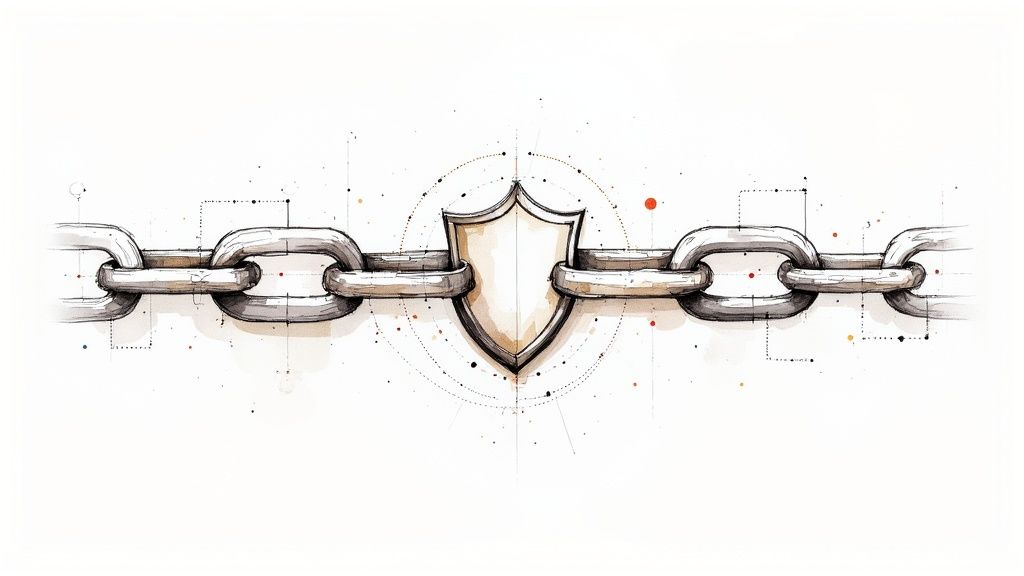
Dependency scanning works by analyzing your project's dependencies against known vulnerability databases (such as the National Vulnerability Database – NVD) and license repositories. It identifies outdated or vulnerable components, flags potential licensing conflicts, and verifies the integrity of the software artifacts used in your build process. Modern tools can automatically scan dependencies at various stages of the CI/CD pipeline – during code integration, build creation, and even post-deployment – ensuring continuous vigilance against emerging threats. This process provides vital visibility into the composition of your applications, empowering you to make informed decisions about which components to include and how to address security concerns.
Successful implementation of supply chain security involves integrating a suite of tools and practices into your CI/CD pipeline. For example, Google’s implementation of the Supply chain Levels for Software Artifacts (SLSA) framework demonstrates a comprehensive approach to ensuring the integrity of software builds. SLSA provides a series of levels, each representing increasing assurance of software provenance and integrity. Similarly, npm’s package signing and audit capabilities allow developers to verify the authenticity and security of JavaScript packages, mitigating risks associated with malicious or compromised packages. Docker Hub’s vulnerability scanning for container images helps identify known vulnerabilities within Docker images before they are deployed to production.
To effectively integrate supply chain security and dependency scanning into your CI/CD pipeline, consider these actionable tips:
- Implement Automated Dependency Updates with Testing: Automate the process of updating dependencies to the latest secure versions. Critically, couple this with automated testing to ensure that updates do not introduce breaking changes.
- Generate and Maintain a Software Bill of Materials (SBOM): An SBOM provides a detailed inventory of all software components, including dependencies, licenses, and versions. It offers crucial transparency and helps track potential vulnerabilities.
- Use Dependency Pinning and Lock Files: Pinning dependencies to specific versions and utilizing lock files ensures consistency and reproducibility across different environments, reducing the risk of unexpected vulnerabilities creeping in.
- Regularly Audit and Remove Unused Dependencies: Unused dependencies represent potential security liabilities. Regularly auditing and removing them minimizes your attack surface.
- Implement Container Image Scanning Before Deployment: Integrate vulnerability scanning tools into your CI/CD pipeline to automatically scan container images for known vulnerabilities before they are deployed to production.
While supply chain security and dependency scanning offer significant advantages, they also have some drawbacks. Scanning tools can generate numerous vulnerability alerts, potentially leading to alert fatigue. Addressing every vulnerability might not be feasible, so prioritization becomes crucial. Additionally, dependency updates, even with testing, can occasionally introduce breaking changes. Finally, while you can meticulously scan dependencies, you have limited control over the security practices of third-party vendors.
Despite these challenges, the benefits of integrating supply chain security and dependency scanning into your CI/CD pipeline significantly outweigh the drawbacks. By proactively identifying and mitigating vulnerabilities in your software supply chain, you enhance the security posture of your applications, protect your organization from breaches, and foster trust with your users. This proactive approach is essential for any organization serious about building secure and reliable software in today's dynamic and interconnected digital world.
4. Infrastructure as Code (IaC) Security
In the fast-paced world of CI/CD, ensuring the security of your infrastructure is paramount. Infrastructure as Code (IaC) has revolutionized how we manage and provision infrastructure, enabling us to define and deploy everything from servers and networks to databases and load balancers through code. However, this automation also introduces potential security risks if not handled correctly. IaC security focuses on mitigating these risks by integrating security practices directly into the IaC workflow, ensuring that security is not an afterthought but a fundamental part of the infrastructure's DNA. This makes it a critical component of any robust CI/CD security best practices strategy.
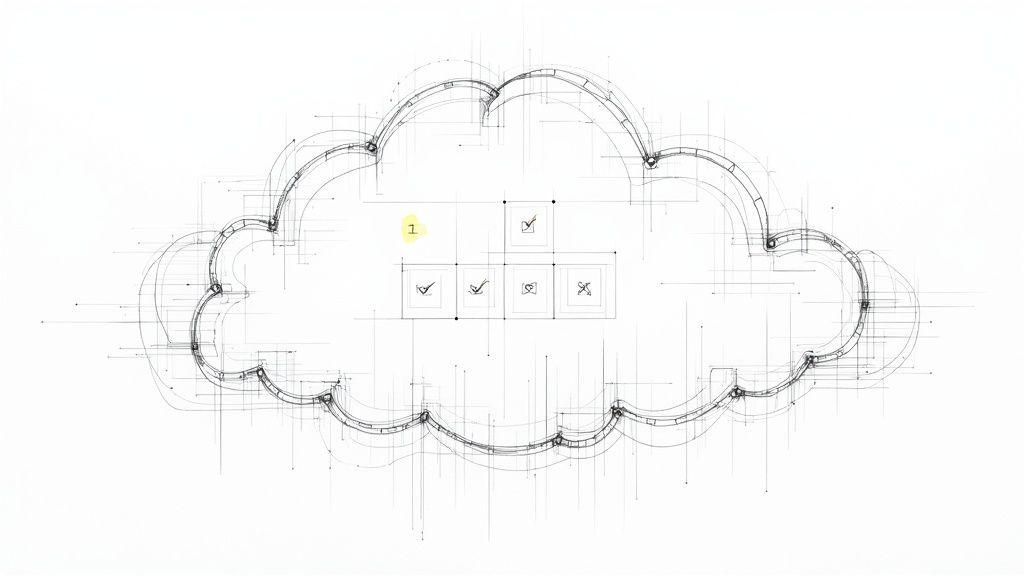
IaC security works by applying security scanning and testing to your IaC templates before they are deployed. These templates, written in languages like Terraform's HCL or AWS CloudFormation's JSON/YAML, define the desired state of your infrastructure. By scanning these templates, you can identify potential misconfigurations, vulnerabilities, and compliance violations early in the development cycle, preventing them from ever reaching production. This proactive approach shifts security left, embedding it into the earliest stages of the CI/CD pipeline. This early detection saves valuable time and resources compared to addressing security issues in a live environment.
Several key features contribute to effective IaC security. Automated IaC template scanning tools can analyze code for common misconfigurations like open ports, insecure access controls, and hardcoded secrets. Cloud security policy enforcement tools integrate with IaC platforms to ensure that deployed infrastructure adheres to organizational security standards. Compliance checking against industry benchmarks like CIS benchmarks helps maintain a strong security posture. Drift detection mechanisms identify deviations from approved configurations, alerting teams to unauthorized changes. Finally, integration with popular IaC tools like Terraform, CloudFormation, Ansible, and Pulumi streamlines the security process.
Numerous organizations have successfully implemented IaC security. Netflix leverages IaC security scanning for their extensive AWS infrastructure, proactively identifying and mitigating potential vulnerabilities. Terraform Cloud uses Sentinel, a policy as code framework, to enforce security and compliance rules across their infrastructure deployments. AWS Config provides continuous monitoring and compliance checking for CloudFormation templates, ensuring adherence to best practices and regulatory requirements.
Implementing IaC security in your CI/CD pipeline offers several significant advantages. It prevents infrastructure misconfigurations before deployment, minimizing the risk of security breaches. It ensures consistent security across different environments (development, testing, production) by enforcing standardized configurations. IaC security enables security policy enforcement at scale, simplifying management across large and complex infrastructures. The early feedback on security issues facilitates faster remediation and reduces the overall cost of addressing vulnerabilities. Finally, it supports compliance with industry security frameworks and regulatory requirements.
While IaC security provides substantial benefits, it’s important to be aware of potential drawbacks. Implementing effective security policies requires security expertise and careful consideration. Initially, integrating security scans into the CI/CD pipeline may slow down infrastructure deployments until the process is optimized. False positives from automated scans can occur, requiring manual review and potentially delaying deployments. Lastly, while IaC security excels at preventing initial misconfigurations, it’s less effective against runtime configuration drift, which necessitates additional monitoring and remediation mechanisms.
To effectively implement IaC security, consider these actionable tips: Implement policy as code for consistent enforcement of security rules across your infrastructure. Utilize security benchmarks like CIS benchmarks to establish baseline policies and ensure a strong security foundation. Integrate IaC template scanning into pull requests for early feedback and faster remediation. Implement infrastructure drift detection and automated remediation to maintain compliance over time. Finally, maintain a library of approved, secure infrastructure patterns to promote consistency and reduce the risk of misconfigurations. By incorporating these practices, you can leverage the power of IaC while maintaining a robust security posture within your CI/CD pipelines.
5. Container and Runtime Security
Container and runtime security is a crucial aspect of CI/CD security best practices, addressing the unique vulnerabilities and challenges presented by containerized environments. It encompasses the entire lifecycle of a container, from the initial build process to its active runtime in production. Ignoring this critical area can expose your applications and infrastructure to significant risks, jeopardizing sensitive data and disrupting operations. By integrating robust container and runtime security measures into your CI/CD pipeline, you can effectively mitigate these risks and ensure the integrity and stability of your containerized applications.
This approach focuses on protecting against container-specific threats such as image vulnerabilities, malicious code injections, and unauthorized access, all while maintaining the agility and scalability that containerization offers. Implementing robust container and runtime security within your CI/CD pipelines strengthens your overall security posture and reinforces confidence in your deployments.
How Container and Runtime Security Works within CI/CD:
Container and runtime security operates on several key principles:
- Shift-Left Security: Security scanning is integrated early in the CI/CD pipeline, starting with image vulnerability scanning during the build process. This prevents vulnerabilities from progressing to later stages and reduces the cost of remediation.
- Automated Security Policy Enforcement: Tools and platforms automatically enforce predefined security policies, such as Pod Security Standards in Kubernetes, ensuring consistent security across all deployments.
- Continuous Monitoring and Threat Detection: Runtime security tools continuously monitor container behavior and network traffic, detecting suspicious activities and potential threats in real time.
- Least Privilege Principle: Containers are granted only the necessary permissions and resources, minimizing the potential impact of a security breach.
Key Features and Benefits:
Several features contribute to effective container and runtime security:
- Container Image Vulnerability Scanning: Automated scanning of container images for known vulnerabilities, using tools like those integrated into Docker Hub.
- Runtime Threat Detection and Monitoring: Real-time monitoring of container activity, detecting anomalies and security threats.
- Security Policy Enforcement: Implementing standards like Pod Security Standards and network policies to restrict container behavior and access.
- Container Isolation and Resource Limits: Isolating containers from each other and the host system, limiting their resource usage to prevent denial-of-service attacks.
- Admission Controllers: Validating container configurations before deployment, ensuring compliance with security policies.
- Container Registry Security and Access Controls: Securing container registries and controlling access to prevent unauthorized image pulls or pushes.
These features contribute to a comprehensive security posture, enabling real-time threat detection and automated policy enforcement, integrating seamlessly with orchestration platforms like Kubernetes, and scaling security effectively for microservices architectures.
Pros and Cons:
Pros:
- Comprehensive protection across the container lifecycle.
- Real-time threat detection and response.
- Automated security policy enforcement.
- Integration with orchestration platforms.
- Scalable security for microservices architectures.
Cons:
- Can be complex to manage security across distributed systems.
- Runtime monitoring can introduce performance overhead.
- Requires specialized container security expertise.
- Implementing in legacy environments can be challenging.
Examples of Successful Implementation:
- Kubernetes uses Pod Security Standards to define security profiles for workloads.
- Docker Hub provides vulnerability scanning for container images.
- Red Hat OpenShift offers integrated container security features.
Learn more about Container and Runtime Security for insights into how Mergify uses Docker image scanning in their CI/CD workflow.
Actionable Tips for Implementing Container and Runtime Security in your CI/CD Pipeline:
- Scan container images in CI/CD pipelines before deployment: Integrate vulnerability scanning tools early in the pipeline to catch vulnerabilities before they reach production.
- Implement least privilege access for containers: Grant containers only the necessary permissions to minimize the potential impact of a security breach.
- Use distroless or minimal base images to reduce attack surface: Smaller images contain fewer dependencies, reducing the number of potential vulnerabilities.
- Enable runtime monitoring and anomaly detection: Identify and respond to suspicious activity in real time.
- Regularly update container base images and dependencies: Patching known vulnerabilities reduces the risk of exploitation.
When and Why to Use This Approach:
Container and runtime security is essential for any organization utilizing containers in their CI/CD pipelines. This is especially crucial for applications handling sensitive data or operating in regulated industries. By incorporating these best practices, organizations can proactively protect their applications and infrastructure from container-specific threats, ensuring the reliability and security of their containerized environments and achieving a more secure and robust CI/CD process.
6. Access Control and Authentication
Access control and authentication are fundamental pillars of CI/CD security best practices. A robust implementation of these principles ensures that only authorized personnel and systems can access, modify, and deploy applications within your CI/CD pipeline. Without proper access control and authentication measures, your entire CI/CD pipeline becomes vulnerable to unauthorized code changes, malicious deployments, and data breaches, severely compromising the integrity and security of your software delivery process. This makes access control and authentication a non-negotiable aspect of any secure CI/CD pipeline.
How it Works:
Access control and authentication in CI/CD leverage Identity and Access Management (IAM) practices. IAM encompasses a range of technologies and policies designed to manage digital identities and their associated permissions. This begins with strong authentication mechanisms, verifying that users are who they claim to be. The most common methods include:
- Multi-Factor Authentication (MFA): MFA adds an extra layer of security by requiring users to provide multiple forms of identification, such as a password and a one-time code from an authenticator app. MFA significantly reduces the risk of unauthorized access even if credentials are compromised.
- Integration with Identity Providers: Leveraging existing identity providers, such as SAML (Security Assertion Markup Language) and OIDC (OpenID Connect), allows centralized user management and streamlined authentication across different CI/CD tools. This simplifies user access while maintaining security.
- API Authentication and Authorization: For automated processes and integrations, secure API authentication and authorization are critical. This typically involves using API keys, tokens, or OAuth 2.0 to ensure that only authorized systems can interact with the CI/CD pipeline.
Once authenticated, access control mechanisms determine what actions a user or system can perform. Role-Based Access Control (RBAC) is a cornerstone of this process. RBAC assigns permissions based on roles within an organization, ensuring that individuals only have access to the resources and actions necessary for their job function. This granular control minimizes the potential impact of compromised accounts and promotes the principle of least privilege.
Successful Implementations:
Several popular CI/CD platforms have implemented robust access control and authentication features:
- GitHub: Offers fine-grained personal access tokens and SAML single sign-on (SSO), allowing developers to control access to specific repositories and actions.
- GitLab: Provides comprehensive RBAC capabilities, including the ability to define custom roles and permissions tailored to specific organizational needs.
- Jenkins: Integrates with various enterprise identity providers for centralized authentication and supports role-based authorization plugins for granular control over pipeline access.
Actionable Tips:
- Implement Just-in-Time Access: Grant access to sensitive resources and operations only when needed, and revoke access immediately afterward. This limits the window of vulnerability and minimizes potential damage from compromised accounts.
- Regularly Review and Audit Access Permissions: Periodically review user roles and permissions to ensure they are still appropriate and revoke any unnecessary access.
- Use Service Accounts with Minimal Required Permissions: For automated processes, create dedicated service accounts with only the necessary permissions to perform their specific tasks.
- Implement Break-Glass Procedures: Establish emergency access procedures for critical situations where standard access control mechanisms may be unavailable. This ensures business continuity while maintaining accountability.
- Monitor and Alert on Unusual Access Patterns: Implement monitoring and alerting systems to detect suspicious activity, such as login attempts from unusual locations or unexpected access requests.
When and Why to Use This Approach:
Access control and authentication are crucial for any CI/CD pipeline, regardless of size or complexity. The benefits of a robust implementation far outweigh the initial setup effort. Specifically, it helps:
- Reduce the risk of unauthorized access: Protects sensitive systems and data from malicious actors.
- Provide granular control over permissions: Ensures that users only have access to the resources they need.
- Support compliance with security frameworks: Helps organizations meet industry regulations and security standards.
- Enable centralized identity management: Simplifies user management and access control across multiple systems.
- Provide comprehensive audit trails: Enables security investigations and helps identify the root cause of security incidents.
While implementing robust access control and authentication might introduce initial complexity and potential friction for users, these challenges are easily mitigated through proper planning, training, and the adoption of user-friendly tools. Ultimately, the security and integrity of your CI/CD pipeline depend on a well-defined and diligently enforced access control and authentication strategy. This makes it a critical component of ci/cd security best practices.
7. Secure Artifact Management and Signing
Secure artifact management and signing is a critical CI/CD security best practice that safeguards the integrity and authenticity of software artifacts throughout the software development lifecycle. This process involves implementing a robust set of security controls around build artifacts—including binaries, container images, libraries, and configuration files—from the moment they are created to their eventual deployment and beyond. By incorporating this practice into your CI/CD pipeline, you establish a foundation for a secure software supply chain, mitigating the risk of deploying compromised or tampered-with code. This is crucial for maintaining the trust of your users and complying with increasingly stringent regulatory requirements.
How it Works:
Secure artifact management starts with generating unique, verifiable signatures for every artifact produced. This is typically done using cryptographic techniques, often leveraging private keys stored securely in hardware security modules (HSMs) to prevent unauthorized access. These digital signatures are then attached to the artifacts, effectively acting as a tamper-proof seal. Along with the signature, other metadata like checksums, timestamps, and build information is often included, creating a comprehensive record of the artifact's provenance.
Subsequently, at every stage of the CI/CD pipeline, these signatures and checksums are verified before any further action is taken. This ensures that only authorized and unmodified artifacts progress through the pipeline, preventing the accidental or malicious introduction of compromised code. Secure storage solutions, like JFrog Artifactory or Sonatype Nexus, play a vital role by providing access controls and enforcing proper artifact handling procedures. These repositories also typically integrate with vulnerability scanning tools, adding another layer of security by identifying known vulnerabilities within the stored artifacts before they reach production.
Examples of Successful Implementation:
- Docker Content Trust: This feature, built into Docker, allows developers to sign and verify container images, providing a secure mechanism for distributing and deploying containerized applications.
- Sigstore: This Linux Foundation project offers free code signing and verification services for open-source projects, making it easier for developers to adopt secure software supply chain practices. Sigstore uses a transparency log to publicly record signatures, making it auditable and further enhancing trust.
- JFrog Artifactory: This enterprise-grade artifact repository manager provides comprehensive artifact security features, including fine-grained access control, digital signing, checksum verification, and integration with various security scanning tools.
Actionable Tips:
- Automate Artifact Signing: Integrate artifact signing directly into your CI/CD pipelines to ensure consistency and prevent human error. Tools like Jenkins, GitLab CI, and GitHub Actions can be configured to automatically sign artifacts upon successful builds.
- Use Hardware Security Modules (HSMs): Protect your signing keys by storing them in HSMs. This provides a high level of security against key compromise and theft.
- Verify Signatures Before Deployment: Implement mandatory signature verification checks before deploying artifacts to any environment, especially production.
- Maintain Detailed Artifact Metadata: Track the origin, build process, and dependencies of each artifact by storing comprehensive metadata. This facilitates quick identification and mitigation of security issues.
- Enforce Artifact Retention Policies: Implement automated artifact retention and cleanup policies to manage storage space and comply with regulatory requirements.
When and Why to Use This Approach:
Secure artifact management and signing is essential for any organization serious about CI/CD security best practices. It's particularly important in the following scenarios:
- Regulated Industries: Industries with strict compliance requirements, such as finance and healthcare, often mandate secure software supply chain practices.
- Large Development Teams: In complex projects with many developers, securing the artifact pipeline is crucial to prevent accidental or malicious code injections.
- Microservice Architectures: With a large number of independently deployed services, ensuring the integrity of each artifact is paramount for overall system stability.
- Open Source Software: Projects using open source components can benefit significantly from artifact signing to verify the authenticity of downloaded libraries and prevent dependency confusion attacks.
Pros and Cons:
Pros:
- Ensures artifact integrity and authenticity
- Provides non-repudiation for build artifacts
- Enables secure software supply chain verification
- Supports compliance with regulatory requirements
- Reduces risk of deploying tampered artifacts
Cons:
- Additional complexity in build and deployment processes
- Requires proper key management infrastructure
- May increase storage and processing overhead
- Potential bottleneck if the signing process is not optimized
By adopting secure artifact management and signing as a core CI/CD security best practice, organizations can significantly enhance the security of their software supply chains, reduce the risk of deploying compromised code, and foster trust in their applications. Implementing the tips and examples outlined above allows you to build a robust and resilient CI/CD pipeline that delivers secure and trustworthy software.
8. Security Testing Automation and DevSecOps Integration
Security is no longer an afterthought in modern software development. Integrating security practices directly into the CI/CD pipeline, a core principle of DevSecOps, is crucial for building resilient and secure applications. Security Testing Automation and DevSecOps Integration, therefore, stands as a critical best practice for any organization practicing CI/CD. This practice involves automating various security tests and weaving them seamlessly into the development lifecycle, enabling continuous security validation and faster remediation of vulnerabilities. By shifting security left and making it an integral part of the CI/CD process, you create a proactive security posture that identifies and addresses vulnerabilities early, minimizing risks and reducing the potential impact of security breaches. This proactive approach is paramount in today's fast-paced development environments, where frequent releases and continuous integration demand a robust and automated security strategy.
This best practice leverages a variety of security testing methodologies, each designed to target specific vulnerabilities and attack vectors. Dynamic Application Security Testing (DAST) simulates real-world attacks against a running application, uncovering vulnerabilities like cross-site scripting (XSS) and SQL injection that might be missed by static analysis. Interactive Application Security Testing (IAST) combines the strengths of SAST and DAST by instrumenting the application code and analyzing its behavior during runtime, providing deeper insights into vulnerabilities with minimal false positives. Automated penetration testing further strengthens the security posture by simulating sophisticated attacks against the application, identifying potential exploitation paths. Security regression testing ensures that new code changes do not introduce new vulnerabilities or reintroduce previously fixed ones.
Successful implementation of Security Testing Automation and DevSecOps Integration can be observed in several organizations. OWASP ZAP, a popular open-source DAST tool, can be seamlessly integrated into CI/CD pipelines like GitLab CI/CD, automating security scans during the build process. Netflix's Security Monkey provides continuous security monitoring of their cloud infrastructure, alerting developers to any security misconfigurations or vulnerabilities. Uber has similarly embedded security testing into their deployment pipeline, ensuring that every code change undergoes rigorous security scrutiny before reaching production.
To effectively implement Security Testing Automation within your CI/CD pipeline, consider the following actionable tips:
- Implement security testing in parallel with functional testing: This minimizes the overall pipeline execution time and allows for faster feedback cycles.
- Use security test environments that mirror production: This ensures that security testing accurately reflects the application's behavior in a real-world scenario.
- Establish security acceptance criteria for user stories: Define clear security requirements for each feature, ensuring that security considerations are addressed from the design phase.
- Automate security regression testing for critical vulnerabilities: This prevents previously fixed vulnerabilities from resurfacing in subsequent releases.
- Integrate security testing results with developer feedback loops: Provide developers with timely and actionable feedback on identified vulnerabilities, enabling quick remediation.
While the benefits are substantial, integrating security testing automation does have potential drawbacks:
- Increased Pipeline Complexity: DAST tools often require running applications, adding complexity to the CI/CD pipeline configuration and potentially impacting performance.
- False Positives: DAST can generate false positives, requiring manual validation and potentially diverting resources from genuine security issues.
- Increased Execution Time: Security testing, especially DAST and penetration testing, can add significant time to the pipeline execution, requiring careful optimization to minimize delays.
- Expertise Required: Configuring and interpreting the results of security testing tools often requires specialized security expertise.
Despite these challenges, the advantages of early vulnerability detection, faster remediation cycles, and reduced manual security testing overhead significantly outweigh the disadvantages. By strategically integrating security testing into the CI/CD pipeline, organizations can build a robust and secure development process that addresses security concerns proactively, reduces risks, and strengthens their overall security posture. The widespread adoption and promotion of these practices by organizations like OWASP, along with major security vendors and cloud security platforms, further solidifies its importance as a ci/cd security best practice.
CI/CD Security Best Practices Comparison
| Best Practice | Implementation Complexity 🔄 | Resource Requirements ⚡ | Expected Outcomes 📊 | Ideal Use Cases 💡 | Key Advantages ⭐ |
|---|---|---|---|---|---|
| Secure Code Scanning and SAST Integration | Medium - requires tool setup and tuning | Moderate - CI/CD integration and rule management | Early vulnerability detection, reduced fix costs | Development pipelines needing early static code analysis | Automated detection, scales with teams, real-time feedback |
| Secret Management and Credential Security | High - needs infrastructure and policies | Moderate to High - secret vaults and access controls | Reduced credential exposure, compliance with audits | Systems handling sensitive credentials and API keys | Centralized secret control, automated rotation, audit logs |
| Supply Chain Security and Dependency Scanning | Medium - continuous monitoring setup | Moderate - scanning tools and SBOM generation | Identification of vulnerable dependencies, license compliance | Projects with extensive third-party dependencies | Visibility into supply chain, automates updates, reduces risk |
| Infrastructure as Code (IaC) Security | Medium to High - writing policies and scans | Moderate - integration with IaC tools | Prevention of misconfigurations, compliance enforcement | Cloud infrastructure provisioning with automated deployments | Early security feedback, policy enforcement, drift detection |
| Container and Runtime Security | High - runtime and orchestration integration | High - monitoring tools and expertise | Real-time threat detection, container lifecycle protection | Containerized microservices and scalable deployments | Comprehensive lifecycle security, policy enforcement, scalable |
| Access Control and Authentication | Medium to High - IAM and policy setup | Moderate - identity provider integration | Granular permission control, reduced unauthorized access | Enterprises requiring strict user and system access control | Centralized IAM, strong compliance support, audit trails |
| Secure Artifact Management and Signing | Medium - signing infrastructure and process | Moderate - key management and storage | Ensures artifact integrity and provenance | Environments requiring strong artifact tamper-proofing | Non-repudiation, supply chain security, regulatory compliance |
| Security Testing Automation and DevSecOps Integration | High - diverse security tests and orchestration | High - security tools and expert interpretation | Continuous runtime and regression security validation | Organizations embedding security throughout CI/CD pipeline | Runtime vulnerability detection, sped-up remediation, shift-left security |
Securing the Future of Your Software
Implementing robust CI/CD security best practices is no longer a luxury but a necessity for modern software development. From secure code scanning and SAST integration to container and runtime security, the strategies discussed in this article provide a comprehensive framework for building a secure software delivery lifecycle. Key takeaways include prioritizing secret management, implementing rigorous dependency scanning, and automating security testing throughout your pipeline. Mastering these concepts strengthens your organization's overall security posture, protects sensitive data, and builds trust with your users.
If a security incident occurs during any stage of your CI/CD pipeline, rapid response is crucial. For immediate assistance and specialized support, consider resources like IT Security Angriff Soforthilfe from Deeken.Technology GmbH.
By weaving security into every stage of your CI/CD pipeline, you're not just mitigating risks – you're building a foundation for continuous innovation and reliable software delivery. Embracing CI/CD security best practices empowers you to confidently navigate the evolving threat landscape and deliver secure, high-quality software in 2025 and beyond. Ready to streamline and further secure your CI/CD workflow? Explore how Mergify can automate tasks, enhance security, and boost your development velocity by intelligently managing your pull requests and merges.




